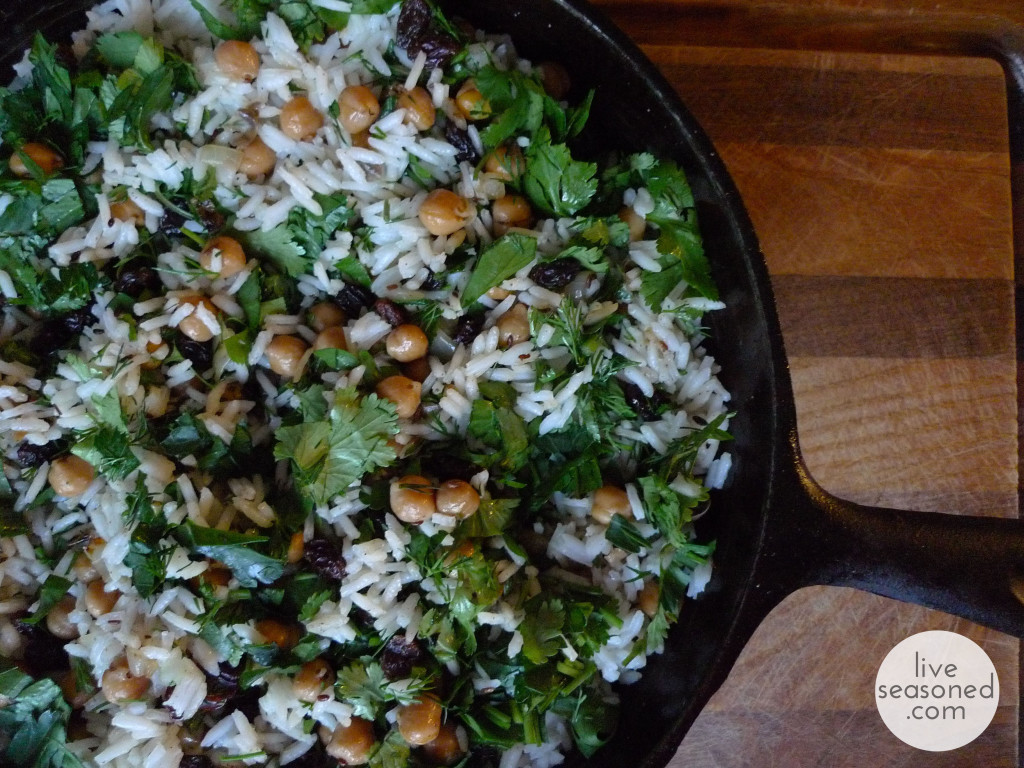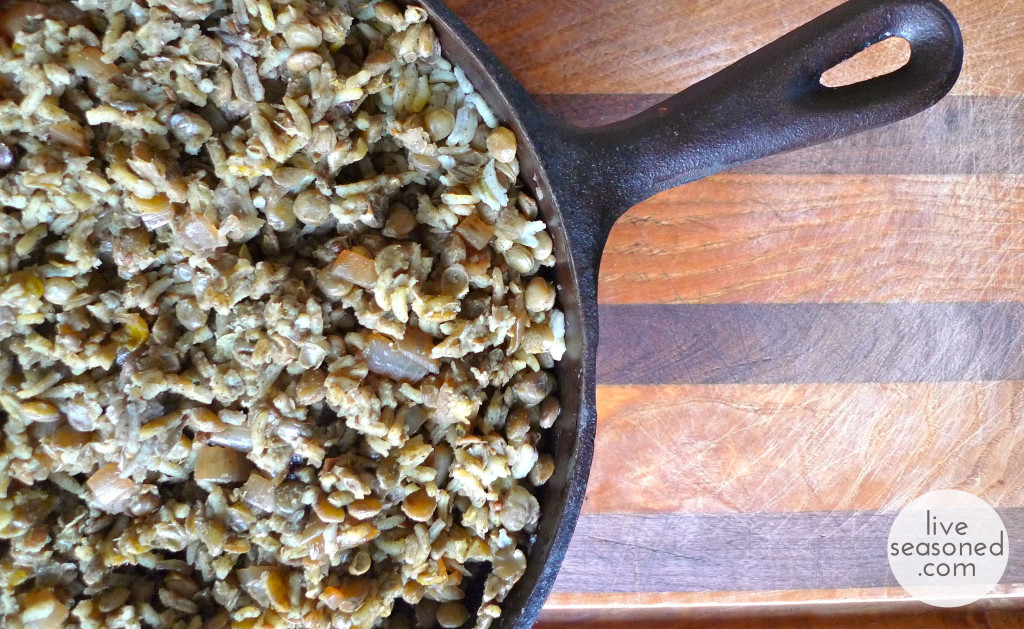I originally wanted to title this post “Rice & Beans Two Ways”. After a bit of research I learned that lentils are not officially a bean, but chickpeas and lentils are both pulses. Pulses are the subset of legumes that are harvested for their dried seeds, differentiating them from other legumes like green beans and peas that are eaten fresh. On with it then…
While the term rice and beans may conjure up images of Mexican or Tex Mex cuisine, today’s dishes reflect the flavors of middle eastern cuisine. I like both recipes because they push me outside of my seasoning comfort zone. We all have that selection of herbs and spices that we use on a regular basis, and we’re happy with the results, so that’s not the issue, but sometimes it’s nice to shake it up, and that’s what these dishes do!
Speaking of seasonings, another good reason to get out of your comfort zone and eat dishes with a variety of herbs and spices is because there are so many health benefits associated with both. Cumin, my favorite spice lately, protects against cancer and encourages the secretion of pancreatic enzymes necessary for good digestion and nutrient absorption. The second recipe contains turmeric, a powerful anti-inflammatory and antioxidant with proven cancer-blocking activities. Parsley’s a rich source of antioxidants and vitamin C, the latter protecting against rheumatoid arthritis. Cinnamon is considered to have one of the richest sources of antioxidants and studies have shown that it lowers the risks for a variety of type 2 diabetes factors.
As I mentioned these recipes are reflective of Middle Eastern cuisine; I discovered them in the cookbook Jerusalem, but I’m sharing my simplified versions below. I found myself making each of these on weeknights, having only just glanced at the recipes at the beginning of the week and not having the precise ingredients on hand. For example, the first recipe called for a mix of basmati and wild rice, I only had basmati, so that’s what I used. Additionally, both recipes called for thinly sliced, breaded, and fried onion rings. They sound fantastic, but between the prep time and general messiness of frying, I decided to skip that in exchange for slow cooking chopped onions.
The recipes make enough for a crowd, so you’ll have plenty of leftovers for a fantastic lunch. And as you’ll see, both dishes can be served warm or at room temperature, also making them the perfect choice for your next party or potluck. Finally, if you’re looking for a serving suggestion, I think both go well paired with roasted chicken (you can cheat like we often do and pick up a pre-roasted chicken from your grocer).
Basmati with Chickpeas, Currants, & Herbs
In my opinion, this recipe is perfect for early spring. Its fresh herbs aren’t a perfect substitute for garden-fresh veggies, but they will do in a pinch at this time of year when you’re still waiting for the farmer’s markets to hit their stride.
Ingredients
- 4 Tbsp olive oil, divided
- 1 cup basmati rice
- 1 1/2 cups boiling water
- 2 tsp cumin seeds
- 1 1/2 tsp curry powder
- 1 1/2 cups cooked and drained chickpeas
- 1 medium onion, chopped
- 2/3 cup currants or raisins
- 2 Tbsp chipped flat-leaf parsley
- 1 Tbsp each chopped cilantro and dill
- salt
Instructions
- Cook the rice. Heat 1 Tbsp of olive oil in a medium saucepan with a tight fitting lid. Add 1/4 tsp salt and the rice and stir to warm it up. Add the boiling water, decrease the heat to low, cover the pan, and allow it to cook for 15 minutes. After 15 minutes, do not uncover the rice; remove the pan from the heat and allow it to sit for an additional 10 minutes.
- Prepare the chickpeas. Heat 1 1/2 Tbsp of olive oil in a small saucepan over high heat. Add the cumin seeds and curry powder, wait for a couple seconds (but not much longer, you don’t want the spices to burn!) and then add the chickpeas and 1/4 tsp salt. Stir the chickpeas for a few minutes until warmed through, and then transfer to a large mixing bowl.
- Cook the onions. Using the same pan that was used for the chickpeas, heat the remaining 1 1/2 Tbsp of oil over medium heat. Add the chopped onions and allow them to cook slowly until they become translucent and begin to brown. You don’t want the heat too high or else the onions will begin to dry and brown too quickly without developing a deep, sweet flavor.
- Mix everything up. Stir the cooked rice and onions into the chickpeas. Add the currants and herbs. Add salt to taste. Serve warm or at room temperature.
Mejadra
Where the herbs in the previous recipe created something fresh, the spices in this recipe create a warmth that is perfect after a day full of April showers.
Ingredients
- 3 Tbsp olive oil, divided
- 1 1/4 cups brown lentils
- 1 medium onion
- 2 tsp cumin seeds
- 1 1/2 Tbsp coriander seeds
- 1 cup basmati rice
- 1/2 tsp ground tumeric
- 1 1/2 tsp each ground allspice and cinnamon
- 1 tsp sugar
- 1 1/2 cups water
- salt
Instructions
- Cook the lentils. Place the lentils in a saucepan and cover with plenty of water. Bring to a boil and cook until the lentils are soft, but not falling apart (about 12-15 minutes).
- Cook the onions. Using the same pan that was used for the chickpeas, heat the remaining 1 1/2 Tbsp of oil over medium heat. Add the chopped onions and allow them to cook slowly until they become translucent and begin to brown. You don’t want the heat too high or else the onions will begin to dry and brown too quickly without developing a deep, sweet flavor. Set the onions aside.
- Cook the rice. Use the same saucepan that you used for the onion. Over medium heat toast the cumin and coriander seeds for a minute or two. Add the rice, 1 1/2 Tbsp olive oil, turmeric, allspice, cinnamon, sugar, and 1/2 tsp salt. Stir to coat the rice with oil, add the cooked lentils and 1 1/2 cups of water. Cover the pan with a lid, bring it to a boil, and then turn the heat down and let it simmer for 15 minutes. When the time is up, keep the pan covered, remove it from the heat, and let it sit for an additional 10 minutes.
- Stir in the onions and serve!
But wait, there’s more! Want one more way to up the nutritional content? Use sea salt rather than your traditional iodized table salt because you’ll get the benefits of additional trace minerals (think calcium, magnesium, potassium).







